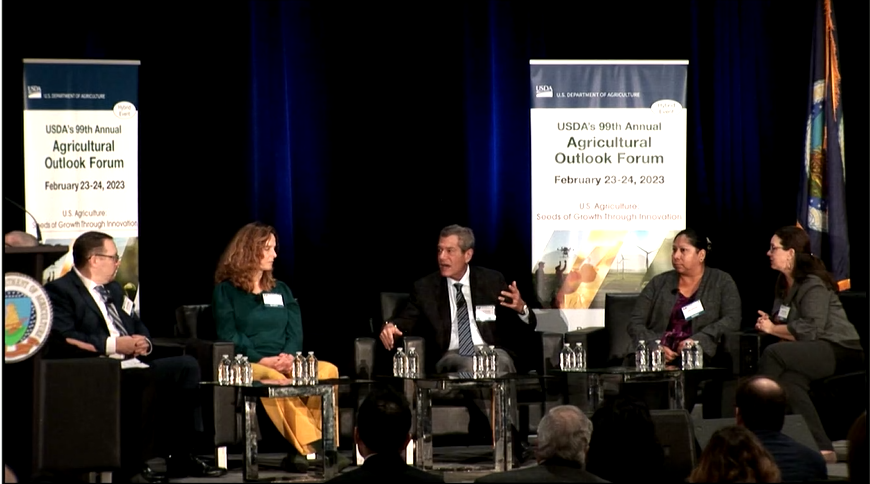Mar 9, 2023USDA session tackles H-2A, labor shortages
To combat increasing labor shortages, growers are adapting labor-saving technology and modifying their cultivation practices, including lessening and delaying pruning and weeding.
The gravity of the crisis was highlighted in a session at the Feb. 23-24 U.S. Department of Agriculture Agricultural Outlook Forum. The decline in the nation’s farmworker supply could create economic consequences, according to participants in the “Workers and the Workforce: Essential Contributors to American Agriculture” panel headed by Secretary of Agriculture Tom Vilsack.
“We hope our Congressional friends take the actions to address the systemic issues growers and farmworkers face,” Vilsack said. “This comprehensive discussion of an issue is not important only to American agriculture, but to all of us. There are people every single day who work incredibly hard to provide us with abundance. We should never take them for granted and should treat them fairly with our consuming dollars.”
Half of growers face labor shortage problems, said Zachariah Rutledge, assistant professor and Extension economist with Michigan State University’s Department of Agricultural, Food, and Resource Economics, who surveys ag employers.
Intense worker shortfalls
Growers reporting labor needs state the average shortage is 20% of the workers they would normally have hired. COVID-19 accelerated existing shortages and forced growers to adjust, by raising wages, providing incentives such as scheduling flexibility, offering health insurance benefits and production bonuses for employee retention and turning to farm labor contractors, Rutledge said.
A significant number of growers are turning to labor-saving technology, with surveys showing the shortages and increasing labor costs as top reasons for two-thirds of growers adapting tech. Growers are altering cultivation practices, with reduced or delayed pruning, weeding and harvesting among the common reported changes, Rutledge said.
While the number of farmworkers isn’t certain, 1.2 million ag jobs remain on the books during an average month, not including recurring turnover, Rutledge said. Specialty crop growers directly hire 45% of the farmworkers with 35% employed in crop services. Up to 70% of farmworkers are foreign-born, with Mexico supplying most of the workers. Half are undocumented.
In fiscal year 2022, more than 370,000 H-2A jobs were certified in the U.S., an increase of more than 300% in the last decade and a doubling over the last five years.
“For the first time in recent history, the U.S. is experiencing a decline in Mexican farm immigration population,” Rutledge said. “There’s also a significant amount of evidence that also indicates that the farm labor supply is declining. It’s impacting producers and many are struggling to adapt. The declining farm labor supply has the potential to reduce domestic ag production, reduce our nation’s stability and impact our national security.”
Ines Hanrahan, executive director of the Washington Tree Fruit Research Commission (WTFRC), said the Union Gap, Washington, organization was formed with the goal of bringing technology, including harvesting automation, to orchards.
“We need to collaborate more on a national and international level,” she said. “We are working with growers to really get robots into the field, especially with harvesting. This is very important because more than 50% of the money farmers spend on specialty crops is spent on picking.”
Palmetto, Florida-based Pacific Tomato Growers, which does business as Sunripe Certified Brands, doesn’t work with labor contractors.
“One of our concerns with the H-2A program, we didn’t want anything between us and our workers, as we had worked so hard to bridge that gap,” said CEO Jon Esformes. “Ultimately, we are the farmer, the ones responsible. I don’t like hearing how more and more labor contractors are becoming a fundamental need in this country.”
Unpredictable payroll
While H-2A enrollment is increasing as growers seek a secure workforce, the unpredictability of the Adverse Effect Wage Rates (AEWR), which sets wages in the program, is a major drawback, according to growers, with double-digit increases common. Rutledge recommends wages in the program be stabilized.
“AEWR is always a contentious point between farmers and other parties,” he said. “Having some provisions to have a stable AEWR that are reasonable would be a good tool.”
A program allowing growers to access workers during labor shortages could be developed, Rutledge said. Hanrahan urged development of a labor sharing program. She pointed to her family’s Yakima Valley tree fruit farm. While they have received enough labor, she said the small farm wouldn’t receive enough workers to harvest a larger than normal crop. Smaller growers also cannot afford to construct or provide housing, Hanrahan said, which is one of the requirements of H-2A enrollment.
Esformes discussed Pacific Tomato’s experience with its workers and the Coalition of Immokalee Workers Fair Food Program. Pacific Tomato was the first Florida tomato grower to adopt the program, which provides worker protections.
“We need a guest worker program that recognizes large industries, particularly ag, need a workforce that can come here whether for six months or a season or a year,” he said. “That needs to be addressed or we will continue to have these conversations and these kinds of problems to maintain production for our country.”
— Doug Ohlemeier, assistant editor
Photo: Zachariah Rutledge (from left), a Michigan State
University Extension economist; Ines Hanrahan, from the Washington Tree Fruit Research Commission; Jon Esformes, with Pacific Tomato Growers; Lupe Gonzalo from the Coalition of Immokalee Workers; and an interpreter, discuss farm worker shortages and H-2A issues during a recent USDA Agricultural Outlook Forum session. Courtesy USDA















